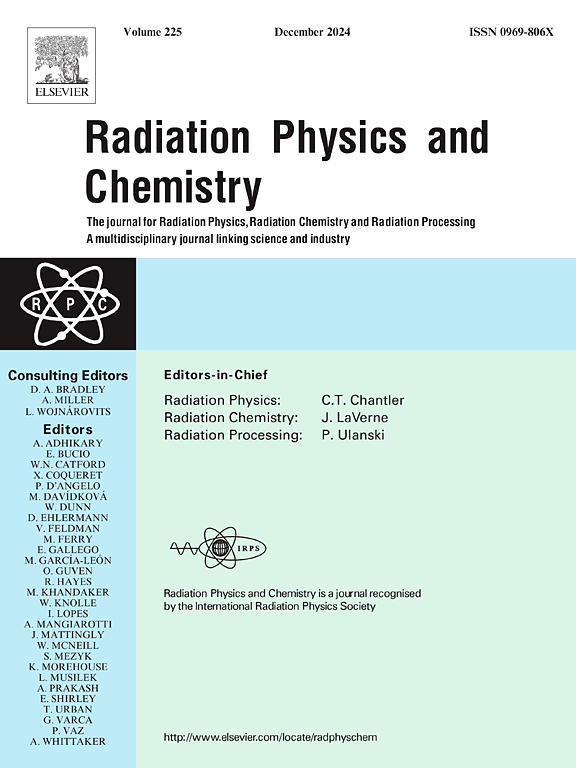由高量子产率Sm3+掺杂Li2O−Gd2O3-ZrO2-P2O5玻璃制成的同步加速器x射线成像材料
IF 2.8
3区 物理与天体物理
Q3 CHEMISTRY, PHYSICAL
引用次数: 0
摘要
磷酸盐玻璃样品的制备采用熔体淬火法制备同步辐射x射线成像用闪烁玻璃。对其物理、光学、结构、光致发光、放射发光特性和x射线成像进行了全面的研究。结果表明,随着Sm3+掺杂浓度的增加,密度和折射率明显增加。吸收光谱显示了紫外-可见-近红外区的吸光度。在Sm2O3含量为0.50 mol%时,光致发光和辐射发光光谱表现出最强的发射强度,光致发光量子产率(PLQY)达到85%。Sm3+离子在600 nm处显示出最强烈的发射峰,这与Sm3+离子的f-f跃迁(4G5/2→6H7/2)有关。随着Sm3+发射强度的增加,Gd3+离子在311 nm处的光致发光(PL)峰值呈下降趋势。这种变化表明发生了从Gd3+到Sm3+离子的能量转移。通过衰减时间分析(λEx = 275 nm, λEm = 311 nm)进一步证实了Sm2O3在浓度为2.00 mol%时的最大能量传递效率为66.08%。Sm3+离子的衰减时间(λEx = 401 nm, λEm = 600 nm)在毫秒范围内,随着Sm2O3浓度的增加,衰减时间从3.156 ms下降到0.944 ms。inokutii - hirayama (IH)模型(S = 6)证实了偶极-偶极相互作用是Sm3+离子间主要的能量传递机制。辐射发光测量显示,相对于标准BGO晶体,其整体闪烁效率为55.39%。使用同步辐射的高分辨率x射线成像表明,该频率下的空间分辨率为10 lp/mm,调制传递函数(MTF)为0.46。这些发现验证了Sm3+掺杂磷酸盐玻璃作为同步加速器x射线成像闪烁体的潜力。本文章由计算机程序翻译,如有差异,请以英文原文为准。
Synchrotron X-ray imaging material from high quantum yield Sm3+- doped Li2O−Gd2O3–ZrO2–P2O5 glass
The fabrication of phosphate glass samples utilized the melt quenching procedure to synthesize the scintillating glass for synchrotron X-ray imaging application.
A comprehensive investigation of the physical, optical, structural, photoluminescence, radioluminescence properties, and X-ray imaging was conducted. The findings exhibited that the density and refractive index clearly increased with higher concentrations of Sm3+ doping.
The absorption spectra revealed absorbance in the UV–Vis–NIR regions.
The photoluminescence and radioluminescence spectra exhibited the strongest emission intensities at 0.50 mol% of Sm2O3, with a remarkable photoluminescence quantum yield (PLQY) of 85 %. The Sm3+ ion revealed its most intense emission peak at 600 nm, relating to the f-f transition (4G5/2 → 6H7/2) of the Sm3+ ion. The photoluminescence (PL) emission peak of Gd3+ ions at 311 nm exhibited a decreasing trend with the concurrent increase in Sm3+ emission intensity. This variation suggests the occurrence of energy transfer from Gd3+ to Sm3+ ions. The energy transfer was further confirmed by decay time analysis (λEx = 275 nm and λEm = 311 nm), which demonstrated a maximum energy transfer efficiency of 66.08 % at a Sm2O3 concentration of 2.00 mol%. The decay time (λEx = 401 nm and λEm = 600 nm)of Sm3+ ion was in the millisecond range, dropping from 3.156 to 0.944 ms when increasing of Sm2O3 concentration. The Inokuti-Hirayama (IH) model (S = 6) confirms dipole–dipole interactions as the primary energy transfer mechanism among Sm3+ ions. Radioluminescence measurements revealed an integral scintillation efficiency of 55.39 % relative to the standard BGO crystal. High-resolution X-ray imaging using synchrotron radiation demonstrated a spatial resolution of 10 lp/mm and a modulation transfer function (MTF) of 0.46 at this frequency. These findings validate the potential of Sm3+-doped phosphate glass as a promising candidate for synchrotron X-ray imaging scintillators.
求助全文
通过发布文献求助,成功后即可免费获取论文全文。
去求助
来源期刊

Radiation Physics and Chemistry
化学-核科学技术
CiteScore
5.60
自引率
17.20%
发文量
574
审稿时长
12 weeks
期刊介绍:
Radiation Physics and Chemistry is a multidisciplinary journal that provides a medium for publication of substantial and original papers, reviews, and short communications which focus on research and developments involving ionizing radiation in radiation physics, radiation chemistry and radiation processing.
The journal aims to publish papers with significance to an international audience, containing substantial novelty and scientific impact. The Editors reserve the rights to reject, with or without external review, papers that do not meet these criteria. This could include papers that are very similar to previous publications, only with changed target substrates, employed materials, analyzed sites and experimental methods, report results without presenting new insights and/or hypothesis testing, or do not focus on the radiation effects.
 求助内容:
求助内容: 应助结果提醒方式:
应助结果提醒方式:


